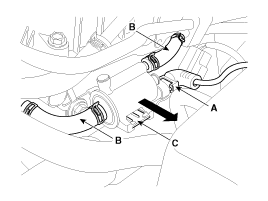 Hyundai Santa Fe: Purge Control Solenoid Valve (PCSV). Repair procedures
Hyundai Santa Fe: Purge Control Solenoid Valve (PCSV). Repair procedures
Inspection
| 1. |
Turn the ignition switch OFF.
|
| 2. |
Disconnect the PCSV connector.
|
| 3. |
Measure resistance between the PCSV terminals 1 and 2.
|
| 4. |
Check that the resistance is within the specification.
|
Removal
| 1. |
Turn the ignition switch OFF and disconnect the battery negative
(-) cable.
|
| 2. |
Disconnect the purge control solenoid valve connector (A).
|
| 3. |
Disconnect the vapor hoses (B) from the purge control solenoid
valve.
|
| 4. |
Remove the valve from the bracket (C) in the direction of the
arrow.
|
Installation
|
|
| 1. |
Install in the reverse order of removal.
|
 Purge Control Solenoid Valve (PCSV). Schematic Diagrams
Purge Control Solenoid Valve (PCSV). Schematic Diagrams
Circuit Diagram ...
 CVVT Oil Control Valve (OCV). Description and Operation
CVVT Oil Control Valve (OCV). Description and Operation
Description Continuous Variable Valve Timing (CVVT) system advances or retards the valve timing of the intake and exhaust valve in accordance with the ECM control signal which is calculated by the engine ...
See also:
Cruise Control Switch. Components and Components Location
Components 1. Remote control switch (LH: Audio) 2. Remote control switch (RH: Cruise + Flex) 3. Bluetooth handfree switch 4. Trip switch ...
Air conditioning
Press the A/C button to turn the air conditioning system on (indicator light will illuminate). Press the button again to turn the air conditioning system off. ...
Components and Components
Location
Component Location 1. Start Stop Button(SSB) 2. FOB key 3. Tailgate open switch 4. RF receiver 5. Interior antenna 1 6. Interior antenna 2 7. Smart key unit 8. Trunk antenna 9. Door handle & door antenna ...

